Pebble Bed Technology -- Nuclear promise or peril?
Air Date: Week of February 24, 2006
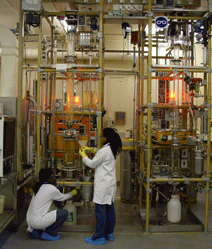
The kernel laboratory of the experimental pebble bed modular reactor. (Photo courtesy of Pelindaba Labs)
A new kind of nuclear power plant is being developed in South Africa. Scientists say pebble bed technology is clean and safe, and will revolutionize the energy industry, especially for developing nations. But critics are concerned about the cost of the pebble bed reactors and about the lack of disposal plans for the radioactive waste.
Transcript
CURWOOD: It's Living on Earth, I'm Steve Curwood. Fusion energy could be decades away, but there's a new type of fission energy that may be just over the horizon. And it comes from a place you might not expect.
[BIRDS AND OUTSIDE AMBIENCE]
CURWOOD: Amid the songbirds and acacia trees of South Africa's high hill country, there's a sprawling complex of brown concrete buildings.
[CAR DRIVES BY. CROSSFADES TO VENTILATION SOUNDS]
CURWOOD: Special air shafts are a tip-off to what goes on inside.
VENTER: The ventilation is specifically designed for working with uranic materials. There are no windows open to the atmosphere here. And you can operate these big areas under a negative pressure, meaning that any leakages would be air coming in and not potentially contaminated air leaking out. When you work with uranium, you have to work clean.
CURWOOD: Fanie Venter is a soft-spoken engineer who's developing a new type of atomic fuel at the Pelindaba Labs.
[VENTILATION; SQUEAKY DOOR]
CURWOOD: His facility has a cloak-and-dagger quality to it. We enter through the bathroom.
VENTER: These buildings, having been built at a time when the programs were of a strategic nature and rather secret, you will only find change rooms for men and women. You don't find separate ones for visitors.
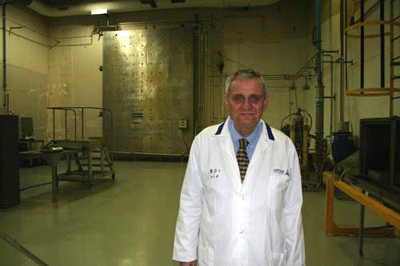
Dr. Fanie Venter manages a team of research scientists who are engineering a new type of fuel for the pebble bed modular reactor project. (Photo: Steve Curwood)
[CORRIDOR SOUNDS]
CURWOOD: During apartheid, parts of Pelindaba were filled with scientists enriching uranium for an atomic bomb. That ended as Nelson Mandela took office more than a decade ago. But the labs here are busy again, with technicians working to make a different kind of nuclear power for South Africa.
[SOUND OF MOTOR]
CURWOOD: The process begins with a tube of bubbly yellow liquid, and a chemical engineer named Annaleen Müller.
MULLER: This is the kernel laboratory, where we manufacture the uranium part of the fuel for the reactor. Okay, you can come and have a look.
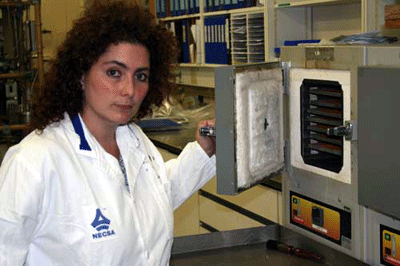
Annaleen Muller dries trays of uranium kernels in a laboratory oven. (Photo: Steve Curwood)
[BUZZING CONVERSION MACHINE]
CURWOOD: Müller converts uranium powder into fuel kernels by dropping it through a bath of ammonia.
MULLER: As the droplet comes out of the nozzle it forms a very soft round droplet. And you might know ammonium diuranate, or ADU, which is well known as yellow cake. So, basically, we are making round little balls of yellow cake.
CURWOOD: They look like tiny little peppers, or tiny mustard seeds.
MULLER: Yes. We'll produce a few million of these kernels during one day's production.
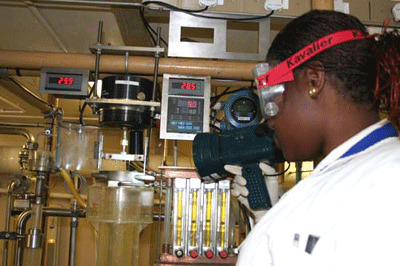
Technicians monitor the formation of "yellow cake" uranium fuel kernels inside the Pelindaba research laboratories in South Africa. (Photo: Steve Curwood)
[PRESS SOUNDS]
CURWOOD: What happens next is what engineers believe will launch a whole new generation of nuclear power. Several thousand kernels are pressed together inside a graphite and ceramic shell.
[PRESS SOUNDS]
CURWOOD: The result is fuel pebble.
[PRESS SOUNDS]
CURWOOD: Can I feel one of these things?
[CURWOOD HOLDS PEBBLE]
CURWOOD: Ah, not very heavy.
VENTER: It's completely round, about the size of a tennis ball.
CURWOOD: Or you could put it on a pool table perhaps and get away with it as a billiard ball. Except it's, well, it's the color of pencil lead, graphite. Humph. Seems all very simple.
[PRESS SOUNDS]
CURWOOD: These test pebbles are made with depleted uranium, so they're safe to handle. But Fanie Venter hopes to make the real thing soon. He says pebbles are the fuel of the future for a new type of atomic station called a pebble bed modular reactor.

Different stages of uranium kernels that go inside the core of the fuel pebble. (Photo courtesy of Pelindaba Labs)
VENTER: The pebble bed reactor is a nuclear reactor where the fuel is in the form of a sphere. And heat flows out of the fuel sphere, and there's helium that comes through the reactor. And it's heated helium that is used to generate electricity.
CURWOOD: So, what's revolutionary about this?
VENTER: It's completely safe because we're talking about ceramic fuel elements. It contains no metal parts. And even if there was a loss of coolant in the reactor, the fuel cannot over heat to the point where you have a meltdown of the fuel sphere.
[LAB SOUNDS]
CURWOOD: The pebble bed concept comes from Germany where experimental plants ran for several years. Now, after a decade of refinements, the South Africans are commercializing the design. They claim the technology is ready for worldwide distribution. The big question is whether the world is ready for a nuclear resurgence.
[LAB SOUNDS; CONFERENCE CROWD SOUNDS]
KRIEK; Welcome: Distinguished guests, ladies and gentlemen, welcome to this historic milestone.
CURWOOD: To build support for the pebble bed initiative, the project invited 350 visitors to South Africa's capital, Pretoria, for a first-of-its-kind international conference.
[VIDEO MUSIC BEGINS: DRUMMING]
CURWOOD: People from 16 countries came to see if they should get involved by supplying parts or services.
[VIDEO NARRATION: South Africa: land of beauty, land of diversity.]
CURWOOD: Video presentations portrayed South Africa's nuclear ambitions as a patriotic turning point for a young democracy...
[CLAASSEN: This project affords a unique opportunity... ]
CURWOOD: ...and the project's key engineers stressed how a pebble bed modular reactor--a PBMR--will be different from today's nuclear plants. Gert Claassen explained they'll be much safer and smaller. And they'll be pre-fabricated in a factory for quick assembly in the field. This will be a major change for the nuclear industry because most existing plants were large, expensive, one-of-a-kind designs.
CLAASSEN: Because PBMR is designed on a modular basis, it affords us the opportunity to say to all the clients that you will buy a standard unit. Today, if you buy a Boeing airplane, you can change the color of the seats and one or two other things, but you buy a standard Boeing aircraft. And that is exactly what PBMR will do.
CURWOOD: This conference featured international experts who claim pebble bed reactors will be part of a global nuclear renaissance. Regis Matzie is chief technology officer with Westinghouse Electric.
MATZIE: When I first got into nuclear energy, we were selling between 30 and 50 reactors a year in the United States. And then it rapidly went down to basically zero. So what we're seeing today is the start. Once we see new plants built in the United States, the Chinese program, the Korea program, the Japanese program. I think you're gonna see a renaissance in Europe, it's just waiting to happen. I think we're gonna see in the next decade what I saw when I started in the industry.
ION: Yeah, I think we're seeing a step change, a paradigm shift, which is great.
CURWOOD: Sue Ion is the technology director for British Nuclear Fuels. She thinks nuclear energy is becoming more attractive because of the growing concern over greenhouse gas emissions from coal-fired power plants. Ms. Ion also says pebble beds have an added benefit that can move them beyond the electricity business. The reactors will operate at extremely high temperatures -- not hot enough to melt the fuel, but hot enough to efficiently desalinate ocean water for drinking. And actually so hot they could crack open molecules of water. That would make it possible to manufacture hydrogen.
ION: When you look to the future, when we want clean means of transportation, where we want to power our cars with something other than gasoline and look to the possibility of fuel cells and hydrogen as a fuel for them, we have to create the hydrogen cleanly. And technology like the pebble bed technology will help us to generate that hydrogen cleanly.
CURWOOD: PBMR engineers are looking primarily to the developing world where urbanization and industrialization are creating tremendous demand for electricity. Robert Hawley, a consultant who used to run the UK's nuclear program, thinks that's wise.
HAWLEY: For a long, long time we've been unable to apply nuclear to developing countries because we couldn't really economically produce small nuclear reactors. The pebble bed fits into that because without electricity you can't have education, you can't keep your food cool, you can't pump water, you can't purify water. So everything in the future for developing countries as we well know depends on electricity. And there's 40 percent of the world without electricity, they've got to have it. Small nuclear reactors like this are the key to the future for the world.
[CONFERENCE CROWD SOUNDS]
CURWOOD: This conference generated the international buzz the organizers were seeking. The pebble bed project has been financed by the South African government's Industrial Development Corporation and the state utility Eskom, along with British Nuclear Fuels. They're confident they'll be ready to construct a demonstration reactor near Cape Town in 2007. They expect South Africa will take at least 20 units from the assembly line starting in 2013, and other countries will buy at least 75 more over a 15-year period. But not everyone in South Africa thinks this is a good idea.
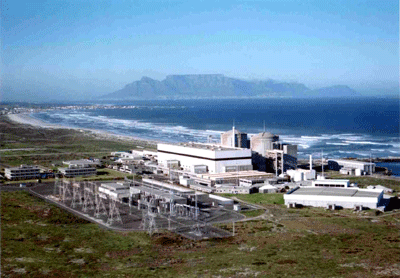
Engineers plan to build a pebble bed test reactor beside Africa's only existing nuclear power plant, the Koeberg station, on the Atlantic coast near Cape Town. (Photo courtesy of Eskom)
WORTHINGTON: In terms of this hype about a nuclear renaissance: well, the nuclear industry have been trying to pull this off for some time now. It may be that it becomes a self-fulfilling prophecy. It may be that with enough hype thrown at it, they get away with being seen as the next big hope for energy.
CURWOOD: Richard Worthington is an activist with Earthlife Africa in Johannesburg. He says the two billion dollars it will cost the South African government to develop pebble bed nuclear plants would be better spent promoting energy conservation, and expanding the use of small-scale renewable technologies like solar and wind.
WORTHINGTON: Do we really think we're going to reduce energy quality in Africa through nuclear power or do we not need to look at the kinds of needs that people have on the ground and the kind of technologies that are human friendly that can be developed at a community level to provide for those energy needs? In South Africa, many people who've been electrified, had their homes electrified, have been cut off because they can't pay the current, relatively low electricity prices. We know that electricity from nuclear is going to be more expensive than what we're selling at the moment. And yet this is being done in the name of the people? No, this is not people-friendly development.
CURWOOD: Worthington isn't the only critic. A British economist who has studied the pebble bed's economic assumptions calls them "ludicrously over-optimistic." And Earthlife community activist Mashile Phalene has other, more basic concerns, such as, there's no disposal plan for the radioactive waste and that the test plant will be close to a heavily-populated area.
PHALENE: The plant is near the people. What about if an accident happen there? We don't want to see a Chernobyl happen. We don't want to see what a Three Mile Island happen.
CURWOOD: But engineers are so confident their new technology is safe, they've determined pebble bed reactors won't need the same level of secondary containment domes or emergency coolant systems found at today's nuclear stations. Phalane says building a demonstration plant near Cape Town will turn residents into guinea pigs.
PHALANE: So it seems we are the test. They are going to be taking tests on the environment there.
CURWOOD: So far, the safety promises of the pebble bed reactor are unproven. And a lawsuit by Earthlife Africa has prompted a judge to throw out the pebble bed's environmental assessment until the public is given a greater say -- about safety, waste disposal and the investment of tax funds.
[APPLAUSE AND POST-CONFERENCE CROWD SOUNDS]
CURWOOD: But the backing of South Africa's government seems solid. As a show of support, three cabinet ministers and the deputy president attended the Pretoria pebble-bed conference. Lindiwe Hendricks is Minister of Minerals and Energy, and Mandisi Mpahlwa is Minister of Trade and Industry.
CURWOOD: You've put a lot of money into this so far. Clearly you think this can make a huge difference to South Africa's economy. Why?
HENDRICKS: Well, number one, jobs are created and South African people will get employment. It is very important to us that our growth and development takes into account the legacy that we have inherited where black people were not able to participate equally. The vision that we have is of a society that is very well integrated, with all the people of South Africa benefiting from the economic growth of the country.
CURWOOD: How do you convince the rest of the world that South Africa can pull this off?
MPAHLWA: Well, I don't think that's going to be very difficult. The technology and engineering issues aren't the biggest challenge for us. It's whether we can sustain the momentum. Because we didn't have the kind of pressures, your strong anti-nuclear lobbies. You have this scenario that this technology, and the extent to which it has been developed in South Africa, is already a few years ahead of everybody else.
[CROWD SOUNDS]
CURWOOD: These ministers believe their nuclear aspirations are a smart strategic gamble. The plants they say will clean-up South Africa's polluted air, provide energy for industrial development, desalinate ocean water for drinking, create a market for the country's vast deposits of uranium ore, and showcase that an African nation can shape its own high-tech future. They say it's wise to build the next generation of nuclear plants themselves instead of buying them from Europe or America.
[LAB SOUNDS]
CURWOOD: The technicians at the Pelindaba Labs are believers, too. Despite the uncertainties that lie ahead, they're already running experiments on the pebbles. This machine slides them along a metal tube, and drops them 12 feet to see if they'll break.
[DROP TEST; VIBRATING SOUNDS]
CURWOOD: In the fuel lab, Analeen Müller uses a special vibrating table to see how many of her uranium kernels are perfectly formed.
MULLER: So you can see all the kernels that have either a dent in it or a flat side, they will hop along to the waste chute, whereas the good ones will run down the slope to the good kernel bottles.
CURWOOD: So in a way this is like panning for gold, huh?
MULLER: Yes, that's true. This is even better than gold. To know that what we are doing here will make a difference to the whole world, is just amazing, it's marvelous.
[KERNEL ROOM SOUNDS]
CURWOOD: Our report on South Africa's nuclear program was produced by Terry FitzPatrick.
Links
Living on Earth wants to hear from you!
Living on Earth
62 Calef Highway, Suite 212
Lee, NH 03861
Telephone: 617-287-4121
E-mail: comments@loe.org
Newsletter [Click here]
Donate to Living on Earth!
Living on Earth is an independent media program and relies entirely on contributions from listeners and institutions supporting public service. Please donate now to preserve an independent environmental voice.
NewsletterLiving on Earth offers a weekly delivery of the show's rundown to your mailbox. Sign up for our newsletter today!
 Sailors For The Sea: Be the change you want to sea.
Sailors For The Sea: Be the change you want to sea.
 The Grantham Foundation for the Protection of the Environment: Committed to protecting and improving the health of the global environment.
The Grantham Foundation for the Protection of the Environment: Committed to protecting and improving the health of the global environment.
 Contribute to Living on Earth and receive, as our gift to you, an archival print of one of Mark Seth Lender's extraordinary wildlife photographs. Follow the link to see Mark's current collection of photographs.
Contribute to Living on Earth and receive, as our gift to you, an archival print of one of Mark Seth Lender's extraordinary wildlife photographs. Follow the link to see Mark's current collection of photographs.
 Buy a signed copy of Mark Seth Lender's book Smeagull the Seagull & support Living on Earth
Buy a signed copy of Mark Seth Lender's book Smeagull the Seagull & support Living on Earth

